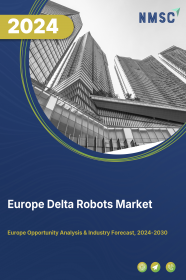
Europe Delta Robots Market by Axis Type (Double Axis, Three Axis, Four Axis, Five Axis, and Six Axis), by Payload Capacity (Up to 3 Kilogram, 3.1 to 8 Kilogram, 8.1 to 15 Kilogram, and More than 15 Kilogram), by Version Environment (Standard and Hygiene), by Application (Assembly, Pick & Place, Material Handling, Palletizing/Packaging, and Others), by Industry Vertical (Electronics, Cosmetics, Food & Beverages, Pharmaceuticals, and Others) – Opportunity Analysis and Industry Forecast, 2023–2030
Industry: ICT & Media | Publish Date: 02-Dec-2024 | No of Pages: 172 | No. of Tables: 145 | No. of Figures: 114 | Format: PDF | Report Code : IC914
Market Definition
Europe Delta Robots Market was valued at USD 474.22 million in 2022, and is predicted to reach USD 1121.8 million by 2030, with a CAGR of 10.43% from 2023 to 2030. Delta or parallel robots are specialized robotic systems known for their distinctive mechanical design and remarkable precision. They consist of three or more arms linked to a shared base, creating a parallel mechanism that provides outstanding accuracy and robust structural stability.
It is widely recognized for their impressive speed, agility, and precision, making them highly suitable for a broad spectrum of high-speed, precision applications in industries such as manufacturing, electronics, food & beverage, pharmaceuticals, and others.
The design of delta robots allows them to move with incredible precision in all three dimensions, such as assembly lines, pick-and-place operations, and intricate manufacturing processes. Making them particularly well-suited for tasks involving pick and place, assembly, packaging, and material handling.
Their parallel kinematic structure, a robotic system design where multiple limbs work parallel to control end-effector motion, enabling precise coordination and control, provides superior rigidity and stability, ensuring consistent and reliable performance. Depending on their specific configuration, they can handle various payloads, ranging from lightweight items to heavier components.
Thus, delta robots are a class of robotic systems renowned for their speed, precision, and versatility. Their unique parallel structure, including rigidity, speed, and stability, makes them a preferred choice for various high-speed automation tasks across multiple industries, contributing to increased efficiency and precision in modern manufacturing and assembly processes.
Surging Demand Across Industries Drives the Adoption of Delta Robots
The escalating demand for delta robots across a multitude of industries in Europe can be attributed to their ability to significantly boost production efficiency, streamline intricate material handling procedures, facilitate meticulous quality inspections, and ultimately enhance overall operational productivity.
These robotic systems, characterized by their exceptional precision and agility, have become indispensable tools for manufacturers seeking to optimize their processes, reduce human error, and meet the growing demands of modern industrial production. Thus, it is expected to drive the growth of the market.
Delta Robots Revolutionizing Production and Packaging in the Food and Beverage Industry
The increasing integration of delta robots in the food and beverage industry is bringing about a significant transformation in production and packaging operations. These robots, with their unmatched speed, precision, and flexibility, are proving to be instrumental in optimizing processes that demand utmost efficiency and accuracy.
By automating tasks such as product sorting, pick-and-place operations, and packaging, delta robots not only ensure higher output and reduced error rates but also adapt seamlessly to changing production requirements. This pivotal role they play in enhancing operational efficiency is a driving force behind the continued growth of the delta robot market in this industry.
The High Cost of Delta Robots Hinders Market Growth in Europe
The market for delta robots faces a significant impediment in the form of their high costs. These robots, renowned for their precision and efficiency, often carry a substantial price tag, which can pose a barrier to adoption for numerous businesses, especially those classified as small and medium-sized enterprises (SMEs).
Furthermore, the prolonged return on investment (ROI) period, resulting from these elevated upfront expenses, can discourage companies that seek more immediate cost reductions and efficiency enhancements. This scenario not only hampers market expansion but also contributes to market concentration, with only larger corporations having the financial capacity to both afford and capitalize on this advanced automation technology.
Integration of Advanced Technologies to Enhance Precision Represents a Significant Opportunity for the Market
Integrating advanced technologies, such as computer vision and artificial intelligence (AI), to enhance precision represents a significant opportunity for the delta robot market. These cutting-edge technologies enable delta robots to operate more accurately and efficiently, opening up new avenues for applications across various industries.
Incorporating computer vision and AI into manufacturing processes not only elevates precision but also bolsters overall productivity while diminishing errors. This integration has the potential to yield cost savings, elevate product quality, and enhance the competitive edge of enterprises utilizing delta robots equipped with these advanced technologies. As industries persist in their embrace of automation and their pursuit of heightened precision and adaptability, the delta robot market is well-positioned to capitalize on the prospects generated by the integration of computer vision and AI.
Competitive Landscape
The Europe Delta Robots industry includes several market players such as ABB Ltd., Fanuc Corporation, Kawasaki Heavy Industries Ltd, Yaskawa Electric Corporation, FESTO, Weiss GmbH, Omron Corporation, IGUS GmbH, Cama Group, and KUKA AG.
Key Benefits
-
The Europe Delta Robots market report provides a quantitative analysis of the current market and estimations through 2023-2030 that assists in identifying the prevailing market opportunities to capitalize on.
-
The study comprises a deep dive analysis of the market trend including the current and future trends for depicting the prevalent investment pockets in the market.
-
The information related to key drivers, restraints, and opportunities and their impact on the market is provided in the report.
-
The competitive analysis of the market players along with their market share in the Europe Delta Robots market.
-
The SWOT analysis and Porter’s Five Forces model are elaborated in the study.
-
Value chain analysis in the market study provides a clear picture of the stakeholders’ roles.
Europe Delta Robots Market Key Segments:
By Axis Type
-
Double Axis
-
Three Axis
-
Four Axis
-
Five Axis
-
Six Axis
By Payload Capacity
-
Upto 3 Kilogram
-
3.1 to 8 Kilogram
-
8.1 to 15 Kilogram
-
More than 15 Kilogram
By Version Environment
-
Standard
-
Hygiene
By Application
-
Assembly
-
Pick & Place
-
Material Handling
-
Palletizing/ Packaging
-
Primary
-
Secondary
-
-
Others
By Industry Vertical
-
Electronics
-
Cosmetics
-
Food & Beverages
-
Pharmaceuticals
-
Others
By Geography
-
Europe
-
UK
-
Germany
-
France
-
Italy
-
Spain
-
Netherlands
-
Rest of Europe
-
Key Players
-
ABB Ltd.
-
Fanuc Corporation
-
Kawasaki Heavy Industries Ltd.
-
Yaskawa Electric Corporation
-
FESTO
-
Weiss GmbH
-
Omron Corporation
-
IGUS GmbH
-
Cama Group
-
KUKA AG
REPORT SCOPE AND SEGMENTATION:
|
Parameters |
Details |
|
Market Size in 2022 |
USD 474.22 Million |
|
Market Volume in 2022 |
22089 Units |
|
Revenue Forecast in 2030 |
USD 1121.8 Million |
|
Growth Rate |
CAGR of 10.43% from 2023 to 2030 |
|
Analysis Period |
2022–2030 |
|
Base Year Considered |
2022 |
|
Forecast Period |
2023–2030 |
|
Market Size Estimation |
Million (USD) |
|
Growth Factors |
Increasing demand for delta robots in a variety of industries. Growing adoption of these robots within the food and beverage sector. |
|
Countries Covered |
6 |
|
Companies Profiled |
10 |
|
Market Share |
Available for 10 companies |
|
Customization Scope |
Free customization (equivalent up to 80 working hours of analysts) after purchase. Addition or alteration to country, regional, and segment scope. |
|
Pricing and Purchase Options |
Avail customized purchase options to meet your exact research needs. |

















 Speak to Our Analyst
Speak to Our Analyst





















